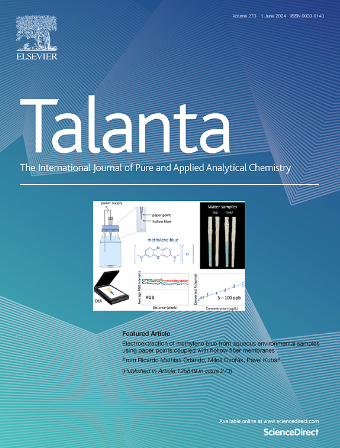泡沫电极电解氢化物发生耦合原子荧光光谱法快速测定真菌样品中的硒(IV)和tSe。
IF 6.1
1区 化学
Q1 CHEMISTRY, ANALYTICAL
引用次数: 0
摘要
准确鉴定痕量重金属元素的关键是在屏蔽基体组分干扰的同时实现高效的进样。本文以电解氢化物生成(EHG)技术为例,探讨了正极材料和结构因素对电合成硒化氢(H2Se)的影响,特别是对抑制共存组分干扰的影响。系统的电化学和光谱测试表明,镍基电极能促进H2Se的生成,而比表面积大、孔隙丰富、析气效应弱的多层泡沫结构提高了电合成反应的产率和稳定性。即使由于高浓度干扰离子的电沉积而使电极表面状态发生变化,硒(Se)的电化学行为也基本不受影响。与原子荧光光谱仪检测器耦合后,检测限低(0.13 μg L-1),线性范围宽(2 ~ 100 μg L-1),信号输出稳定(RSD为3.3%,n = 11)。在高频超声样品提取和预还原措施的帮助下,蘑菇等真菌样品中的Se(IV)和总Se(tSe)可以快速定量,而无需对基质进行预分离。本研究的贡献在于为复杂基质中痕量甚至超痕量重金属元素的光谱定量分析提供一种经济、可持续的电化学气体分离策略。本文章由计算机程序翻译,如有差异,请以英文原文为准。

Rapid determination of Se(IV) and tSe in fungal samples by foam electrode-based electrolytic hydride generation coupled atomic fluorescence spectrometry
The key to accurately identifying trace heavy metal elements is to achieve efficient sample introduction while shielding the interference of matrix components. Taking the electrolytic hydride generation (EHG) technology as an example, this paper explored the effects of cathode materials and structural factors on the electrosynthesis of hydrogen selenide (H2Se), particularly on suppressing interference from coexisting components. Systematic electrochemical and spectroscopic tests show that the nickel-based electrode can promote the generation of H2Se, while the multi-layer foam structure with large specific surface area, rich pores and weak gas evolution effect improves the yield and stability of electrosynthesis reaction. Even if the surface state of the electrode changes due to the electrodeposition of high concentration interference ion, the electrochemical behavior of selenium (Se) is basically not affected. After coupling with an atomic fluorescence spectrometer detector, this method has a low detection limit (0.13 μg L−1), a wide linear range (2–100 μg L−1), and stable signal output (RSD, 3.3%, n = 11). With the assistance of high-frequency ultrasound sample extraction and pre-reduction measures, Se(IV) and total Se (tSe) in fungal samples such as mushrooms can be quickly quantified without pre-separation of the matrix. The contribution of this study is to provide an economical and sustainable electrochemical gas separation strategy for spectroscopic quantification of trace and even ultra-trace heavy metal elements in complex matrices.
求助全文
通过发布文献求助,成功后即可免费获取论文全文。
去求助
来源期刊

Talanta
化学-分析化学
CiteScore
12.30
自引率
4.90%
发文量
861
审稿时长
29 days
期刊介绍:
Talanta provides a forum for the publication of original research papers, short communications, and critical reviews in all branches of pure and applied analytical chemistry. Papers are evaluated based on established guidelines, including the fundamental nature of the study, scientific novelty, substantial improvement or advantage over existing technology or methods, and demonstrated analytical applicability. Original research papers on fundamental studies, and on novel sensor and instrumentation developments, are encouraged. Novel or improved applications in areas such as clinical and biological chemistry, environmental analysis, geochemistry, materials science and engineering, and analytical platforms for omics development are welcome.
Analytical performance of methods should be determined, including interference and matrix effects, and methods should be validated by comparison with a standard method, or analysis of a certified reference material. Simple spiking recoveries may not be sufficient. The developed method should especially comprise information on selectivity, sensitivity, detection limits, accuracy, and reliability. However, applying official validation or robustness studies to a routine method or technique does not necessarily constitute novelty. Proper statistical treatment of the data should be provided. Relevant literature should be cited, including related publications by the authors, and authors should discuss how their proposed methodology compares with previously reported methods.
 求助内容:
求助内容: 应助结果提醒方式:
应助结果提醒方式:


